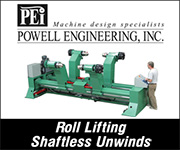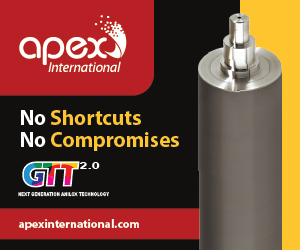Featured Stories
-
Elevating Pouch Manufacturing with Pearl Technologies' Cutting-Edge Solutions
For manufacturers seeking efficiency, precision, and safety in pouch production, Pearl delivers unmatched innovation across three standout... -
Faster Product Composition Analysis Equals Better Quality Assurance
Near Instant Testing and Reduced Costs to be Found -
Methods to Precisely Measure Tension and Web Control
How to Control Automatically Within Set Parameters
News | New Products
-
Convertech Brand to Fully Transition to Double E Group Same Team, Same Excellence, Unified Name
Double E Group has announced that Convertech, one of its subsidiaries and a trusted provider of core chucks and shaft solutions for the converting industry, will now operate solely under the Double E Group brand.
-
Pulse is Making Print Simple at Labelexpo Europe 2025
Narrow web ink specialist Pulse is Making Print Simple at Labelexpo Europe 2025, as it challenges flexo printers to rethink how they work and shows solutions that turn production bottlenecks into revenue generators.
-
ROTOCON to debut at Labelexpo Europe with three machine demonstrations
ROTOCON will make its Labelexpo Europe debut, exhibiting together with HS Machinery on stand 4D21.
-
At Interphex Japan, IL Group to Showcase Innovative Labeling Solutions and Contract Packaging Services
IL Group, a specialist in multifunctional labeling solutions for the pharmaceuticals and healthcare sectors
-
Revolutionizing Adherence: Clinical Trials Go Digital with Enhanced Key-Pak®
Keystone Folding Box Co., a leading provider of paperboard packaging solutions, has announced a strategic partnership with Med-Con Technologies
-
Innovating for Circularity: How New Sustainability Initiatives Are Shaping the Future of Labeling
In the face of growing regulatory, environmental and consumer pressures, the packaging and labeling industry continues to advance technologies and solutions that help to support a circular economy.
-
New Product Development: RKW Horizon®–MDO-PE Films with EVOH Barrier
RKW Horizon® is the new generation of sustainable PE plastic films based on the latest MDO technology.
Expert Advice
Ink 101: Part I
- Published: September 01, 2006, By By David Argent Contributing Editor
It is estimated the total North American (US and Canada) market for packaging materials is approximately $125 billion in annual shipments. Ink is a relatively minor cost component of the packaging, yet it is the primary link to the consumer market in terms of shelf appeal and consumer acceptance.
During converting operations, ink management as a discipline is a key to productivity and low waste. The table below shows a breakdown of ink usage, which is small in comparison to the total for packaging.
| Item | Flexo | Offset | Gravure | Total |
|---|---|---|---|---|
| Total | 1,260 | 310 | 230 | 1,800 |
| Corrugated | 360 | 30 | NA | 390 |
| Flexible Packaging | 660 | NA | 125 | 785 |
| Folding Carton | 80 | 200 | 80 | 360 |
| Label | 160 | 80 | 25 | 265 |
There are three main printing processes used in packaging: flexo, gravure, and litho. There are four different ink chemistries used: water-based, solvent-based, oil-based, and energy cured. Not every chemistry is applicable to every printing method. Below is a summary.
| Printing Processes | ||||
|---|---|---|---|---|
| Ink Chemistries | Flexo | Offset | Gravure | |
| Solvent | Yes | No | Yes | |
| Water | Yes | No | Yes | |
| Oil | No | Yes | No | |
| Energy Cured | Yes | Yes | No | |
Typical packaging applications for water-based inks include liquid packaging, aseptic packaging, cups and plates, corrugated containers, multiwall bags, beverage carriers, gift wrap, folding cartons, towel and tissue, and retail bags.
Typical applications for solvent-based inks are bread bags, frozen food bags, candy wrap, snack foods, meat and cheese wrappers, stand-up pouches, and towel/tissue overwrap. Use of water-based inks is almost exclusively for paper and board substrates where adhesion, wetting, and drying are facilitated by the substrate porosity. Solvent-based inks are used on film and foil substrates. Energy-cured inks are fully developed and in day-to-day use for litho printing. Their use in flexo is small but growing.
If we accept that the packaging market is relatively mature and proven in terms of materials and equipment in current use, then what is the basis of competition? If everyone has access to equivalent technology, that leaves us with opportunities for improvement in process design, control, and measurement.
However, all too often materials going into the press are selected in isolation, and when combined in a manufacturing process, they may or may not be conducive to high quality, low cost, and low waste. Ink is a relatively minor cost component with a major impact on converting and often does not get the attention required for optimum performance. Two tough questions for converters are: “What is your waste level, and how does this affect your bottom line?”
In the previous issue, this column discussed process modeling, and the concept of a dynamic workflow of “input-transform-output” was introduced. There are measurable and predictable relationships among ink composition, ink density, ink film thickness, press configuration, press efficiency, print quality, cost of use, and end-use properties. These relationships are controlled by system design and will be explored in upcoming issues of PFFC.
David Argent has 30+ years of experience in the converting industry. He specializes in process analysis and improvement with particular emphasis on ink and coating design and performance. Contact him at 636/391-8180; djvargent@sbcglobal.net






















